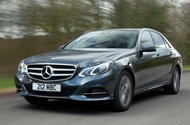The E-Class is a refined and relaxing return to old Mercedes qualities – a truly brilliant used purchase
Many people’s experience of the W212, the fourth generation (2009-2016) of Mercedes-Benz E-Class, is probably being whisked to the airport in a saloon. Impressed by its spaciousness, refinement and deep- rooted quality, they glance at the instrument cluster to discover that it has done way over 200,000 miles. One day, they promise themselves, they will have one of these…Well, with £14,000, buying one of the last 2016-reg diesels (a Euro 6- compliant E220 Bluetec AMG Night Edition auto with a reasonable 70,000 miles), that day has come.Alternatively, the estate, with its 1950 litres of seats-down load space and self-levelling rear suspension, is only around £1000 more for the same year and spec. There’s a coupé and a convertible, too, but here we’re concerned with the saloon and estate.The model mix for buyers is skewed towards diesel saloons. Specifically, saloons outnumber estates by about three to one, while diesels outnumber petrols 13 to one. There’s a good range of diesels on offer.The four-cylinder 2.1-litre engine, available in four power outputs, is the bedrock of the line-up. We prefer the 202bhp E250 CDI’s strong performance and decent real-world economy over the slower E200 CDI and E220 CDI versions. The economy champion, the saloon and estate.The model mix for buyers is skewed towards diesel saloons. Specifically, saloons outnumber estates by about three to one, while diesels outnumber petrols 13 to one.There’s a good range of diesels on offer. The four-cylinder 2.1-litre engine, available in four power outputs, is the bedrock of the line-up. We prefer the 202bhp E250 CDI’s strong performance and decent real-world economy over the slower E200 CDI and E220 CDI versions.The economy champion, though, is the E300dh, a 228bhp 2.1-litre diesel hybrid, which can do almost 70mpg. The 3.0-litre V6 E350 CDI is quicker but much thirstier.The majority of diesels are Euro 5-compliant, but from 2014 the E220 CDI and E350 CDI, badged Bluetec, are Euro 6. The E250 CDI, meanwhile, didn’t get the Bluetec treatment and remained Euro 5 until its retirement in 2015.Turning to the petrols, logic says you should ignore the small 1.8-litre E250 CGI, but it pumps out a decent 201bhp and the few we found are low-mileage private cars with good histories. The rare 288bhp 3.5-litre V6-engined 350CGI is an interesting alternative and capable of 0-62mph in 6.8sec and 30mpg.Also interesting is the ultra-rare petrol-electric plug-in hybrid: the 2.0-litre, 6.4kWh E350e.Next up is a 5.5-litre V8. Surprisingly, given their original high list prices, the number of available E63s is well into double figures.’Facelift’ doesn’t describe the revisions made to the E-Class for the 2013 model year. Reputed to be the most significant revision Mercedes had yet made to a model, it cost £1 billion in development – about what an all-new model would cost.The adoption of single headlights, a simplified front grille and a refreshed interior were the obvious visual changes. They were accompanies by improvements to the engines and an increase in equipment, including a choice of suspension systems.Safety, already high, was upped by the optional driver assistance features from the S-Class.As for trims, Avantgarde and SE veer towards comfort while sportier versions, with their larger wheels and firmer suspension, offer a more jarring ride.Fortunately, on later cars, it can be partially dialled out by the various suspension modes.A BMW 5 Series will be sharper and an Audi A6 will feel at least as well built, but a well-bought, Mk4 E-Class saloon or estate will slip unobtrusively into your life, providing high levels of comfort and practicality in one desirable and durable package. Mercedes-Benz E-Class 2009-2016 common problemsEngine: There have been reports of some cars throwing their timing chains, so listen for rattles when the engine is warm. The 220 CDI and 250 CDI engines have experienced faulty Delphi fuel injectors. Check for coolant leaks on the 250 CDI.Gearbox: The automatic gearbox requires fresh fluid every three years or 50,000 miles. Check that changes are smooth at all speeds.Suspension: Depending on the system, be sure all suspension modes work. If it’s an estate, check the operation of the Airmatic self-levelling suspension. Problems may be with the suspension itself or the level sensor linkage.Brakes and tyres: The E-Class can get through front brake discs in as little as 13,000 miles. Premium-brand tyres all round suggest careful ownership.Interior: Not all Comand system sat-navs accept UK postcodes, although they can be upgraded. On Euro 6 diesels, the AdBlue tank takes the place of the spare wheel. The E-Class’s superb build quality disguises high mileage well, so check that the car hasn’t been clocked. Scrutinise the dashboard for warning lights. Make sure the climate control isn’t blowing more cold air than necessary. If it’s an estate, inspect the headlining and the load area for damage.Body: There are reports of windscreens on 2009-2015 cars being prone to cracking. Inspect the rear subframe, axle and wheel nuts for heavy corrosion. Check the condition of the auxiliary battery in the boot.







